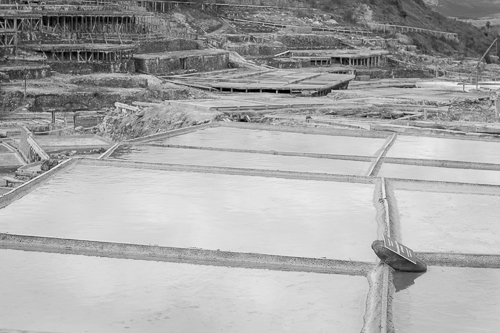Having left Quesos Ugala, we went to Valle Salado de Añana, which is a salt works located next to the village of Añana. Salt pans were formed in this valley several hundred millions years ago. In fact, the valley of Añana was once covered by an ocean which dried up, leaving a layer of salt several kilometres thick. Approaching the salt works, we could see man-made structures covering a large part of the valley.
Since this valley is also blessed with sources which bring salt water to the surface of the earth, man has extracted salt in this valley for thousands of years. In fact, archaeologists have found traces from the Stone Age when brine was collected in jars, then the water was boiled until only salt was left. Finally, the jars were destroyed in order to get hold of the salt. This process is called briquetage. Since salt preserves food by killing bacteria, it has been valuable for millennia.
There are also traces from extraction of salt by the Romans, while documents on the salt works dates back more than 1000 years.
The salt production lasts from June to September, meaning that it had stopped when we visited the salt works. Anyway, our guide knew the salt works well and gave us a good introduction to the place. Before we could enter, she used a wooden key to open a gate since any tool of metal will corrode. Having entered, we could see ponds with areas of some square metres filled with water and being limited by clay and wooden boards like formwork. Later, we would also pass basins of concrete which had been destroyed by the salt. In order to make a basin withstand the effects of salt, a flat piece of clay is covered by ceramic tiles which would form the base of the basin.
The salt water from springs is collected by slightly inclining chutes such that it flows downwards by means of gravity. In order to fill a pond or change the direction of water, there were holes in the sides of the chutes. In general, they were covered by clay, but just by removing it, water could be let out of the chute. There were also several wells where salt water was collected. A pond was placed above the well, and in order to fetch water from the well to the pond, a lever with a wooden bucket in one end and a weight in the other end was used. First, the bucket was lowered in the well and filled with water, then it was lifted up quite easily because of the weight at the other end of the lever. Finally, the bucket was emptied in the pond. In summer, the water will stay in the pond, letting the heat of the sun evaporate the water and leave the salt. A worker with a wooden tool will collect the salt by dragging it from the sides to the centre of the pond and put it in a bucket.
Walking around the salt works, our guide showed us a chute which had 12 holes on one side and 13 on the other in order to control the flow of water to two other chutes. She also showed us tiny, red fish which lived in the salt water and a well from which flowed bubbles continuously.
Walking around the salt works, it was impossible not to notice that the undersides of the chutes where covered with salt, sometimes in layers, but also forming crystals. There were also stalactites forming vertical columns below the chutes. Our guide told us that they are works of nature and that some persons have tried to make them artificially without success.
On our way back to the entrance, we passed the salt production house where workers were packing salt manually. We weren’t allowed to enter, but one of the workers came outside and showed us flakes of salt. In fact, the policy of this company is to produce salt of the highest quality, while the extracted amount of salt always has to take second place. Lots of Basque cooks use salt from the salt works, which sells salt to gourmet restaurants. Before we left, we entered the shop where we could buy high quality salt in attractive saltcellars.

